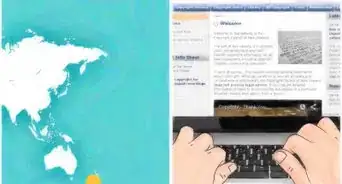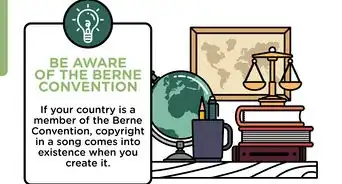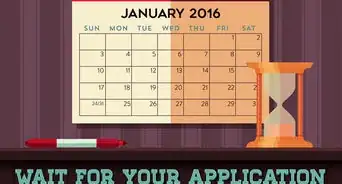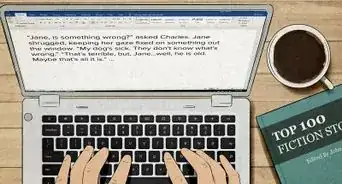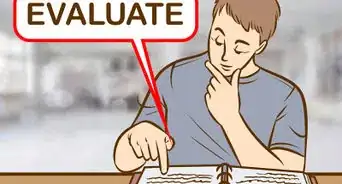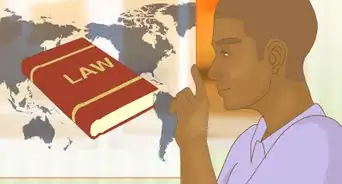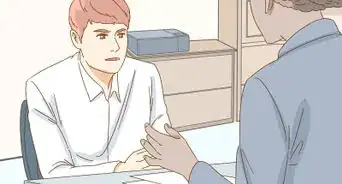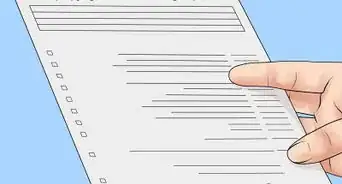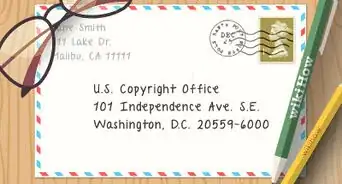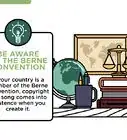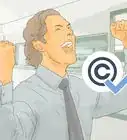This article was co-authored by Clinton M. Sandvick, JD, PhD. Clinton M. Sandvick worked as a civil litigator in California for over 7 years. He received his JD from the University of Wisconsin-Madison in 1998 and his PhD in American History from the University of Oregon in 2013.
There are 20 references cited in this article, which can be found at the bottom of the page.
wikiHow marks an article as reader-approved once it receives enough positive feedback. This article received 18 testimonials and 96% of readers who voted found it helpful, earning it our reader-approved status.
This article has been viewed 273,281 times.
Copyright is a form of protection for original works of authorship, both published and unpublished. It is used by writers, musicians, artists, and others to protect their work from unauthorized commercial use. The first copyright law in the United States was enacted by Congress in 1790.[1] U.S. copyright law, combined with treaties with other countries, protects authors' rights domestically and abroad.[2]
Steps
Understanding Copyright Protection
-
1Automatically acquire a copyright of your work the moment you create it. Your work is automatically protected by copyright when it is "fixed in a tangible form," like a writing or drawing on a piece of paper.[3] This means the U.S. copyright laws apply to your work as soon as you produce it, write it, record it, or draw it.
- Remember, it isn't enough just to be the first to voice your idea or invention. If you tell someone your idea, but that person describes it in their own words in a tangible form (e.g., writes it down) first, then that person owns the copyright of that description, not you.
- This "first to record" rule would not apply if you authorized the person to record your words for you, as you remain the "author" of the words that they record.
- Under US law, you do not own the copyright of a recording you make of a live public performance of music unless you obtained the permission of the performers.[4] You could be sued for infringement for making it or sharing it online or anywhere else.
-
2Understand the difference between a copyright, a patent and a trademark. Copyright protects original works of authorship created by you. A patent protects inventions and useful discoveries. Trademark protects distinctive words, phrases, symbols, sounds and designs. Trademarks identify and distinguish the source of the goods (and services) of one party from those of another party.[5]Advertisement
-
3Know what types of work are protected by copyright. Copyright protects original, tangible work you have created including things like writings, drawings, photographs, books and poems. It also protects:
- movies and soundtracks
- choreography and dramatic works
- songs and sound recordings
- artistic works like paintings and sculptures
- computer software programs
- architecture plans and drawings[6]
-
4Understand what is not protected by copyright. Ideas are not protected by copyright law although the way they are expressed, in writing or otherwise, may be protected. Copyright also does not protect:
-
5Enjoy the ownership rights of your copyright. Your copyright affords you the exclusive right to make copies of your protected work, sell it, and distribute it. Your copyright also allows you to create adaptations, translations or derivative pieces from your work, perform your work (e.g. like in a play or concert or public reading) and display your work in public.[9]
- Your exclusive rights are subject to limitations such as "fair use", "first sale", certain educational and non-profit uses, backup (archival) copies of computer programs, among other things. [10]
- You may choose to authorize others, via license, to exercise some or all of your exclusive rights either for compensation or as a courtesy.
- You cannot prevent others from making personal copies of sound recordings that they lawfully acquired, provided it is non-commercial use of the recording device. [11]
-
6Understand ownership of "works made for hire". Works may be made for an employer or for a client under an independent contract. The law determines who is the original owner of the copyright, which also determines the copyright duration.
- If a work is created by an employee as part of their work, then the employer is considered "the author" and owns the copyright.
- If you hire an independent contractor, they own the copyright of their creations unless expressly agreed otherwise in a signed writing. This is important if you hire an independent contractor and you want to own and enforce the copyright in the resulting works.[12]
- Complex issues arise when collaborating with others in a jointly authored work.
- Not all types of works qualify as "works for hire" under an independent contract, meaning the resulting ownership may be different from what was intended, absent a clear transfer of ownership. [13]
-
7Know when copyright protection ends. For works created in 1978 or later, a copyright generally lasts for the duration of the last living author's life, plus an additional 70 years. If the work was made for hire, anonymous, or created under a pseudonym, the copyright lasts for the shorter of 95 years from the first publication or 120 years from the creation.[14]
- Works created prior to 1978 may be subject to different duration rules, depending on when they were created, when or if they were published, how they were created, what types of works they are, and whether the copyright was renewed. .[15] You can find an overview of various copyright terms here.
- There is no longer any need to renew a copyright. Works published in or after 1964 automatically have their maximum copyright term. For works published after 1922 and prior to 1964, the chance to renew expired 28 years later.[16] Those works would have a copyright with duration of 95 years, if renewed, regardless of when the authors died.
- Works of US authors published in the US without proper copyright notice or registration (prior to 1989) and any necessary renewal (published prior to 1964) have no US copyright.
- Since the copyright to your creation will extend beyond your life, you should consider to whom you would like to leave the rights to your work when you die.[17] Keep your copyrighted work in mind when writing a will or creating an estate plan.
- You may also transfer ownership of your US copyrights to others by a written and signed document, but it will have the same duration as before transfer regardless of who owns it.[18] Transfers may be recorded in the Copyright Office.
- Sound recordings first published in the USA prior to 1972 have no US federal copyright, but may be protected against unauthorized duplication under various state laws until 2067.
- Different rules for duration may apply to works first published in a foreign country.
Registering a Copyright
-
1Consider the reasons to register your copyright. If you so wish, you can register your copyright with the U.S. Copyright office. You might choose to register your copyright for several reasons:
- A registered copyright is a matter of public record.
- Registered copyright holders receive a certificate of registration from the U.S. Copyright Office.
- You must register your copyright before you bring a lawsuit related to infringement of your work.[19]
- Works with timely registration may be eligible for statutory damages and attorney's fees if you win a lawsuit to protect your rights.[20]
- If you register your work within five years of the first publication of the work, the registration is considered prima facie evidence, which puts the burden on the other party to prove that they had a copyright to the original work before you did.[21] [22]
-
2Register your copyright online. The process of registering your copyright online is easy. Visit the U.S. Copyright Office's online registration site, the eCO system. You will need to register an account with the office to start your application.
- A comprehensive tutorial is available here.
- You will need to create a digital version of your work and upload it with the application. You can also request a shipping label so that you can mail your work to the office, instead.[23]
- Pay the filing fee online and submit your application. Refer to the Fee page of the U.S. Copyright Office to find the current filing fee for filing a copyright and write a check for the filing fee.
-
3Register your copyright by mail. You can choose to register by mail instead by visiting the Forms page of the U.S. Copyright Office website. Select the appropriate form for filing. For example, if you are registering a novel, you select the Literary Form (Form TX), if you are registering a music or voice recording, you select the Sound Recording Form (Form SR).
- Print out the form and complete it. Refer to the form for guidance as to the number of copies of your work you need to include with your package and the mailing address.
- Make a copy or copies of your copyrighted work.
- Refer to the Fee page of the U.S. Copyright Office to find the current filing fee for filing a copyright and write a check for the filing fee.
- Package your application, check and copyrighted work together in one package. If you are mailing items like CDs, DVDs or other fragile materials, it is best to place them in a box with sufficient packaging so they do not get damaged.
-
4Receive your certificate of registration by mail. After you have filed your application, whether by mail or online, it will be examined and usually approved. If approved, you will receive a certificate of registration from the U.S. Copyright Office. This certificate is proof that your work is registered with the U.S. Copyright Office.
- If your application is rejected, you will be notified of the reason and given a chance to file an appeal. One basis for denial is for material that does not qualify for copyright.
Protecting Your Copyright
-
1Add a notice to your copyrighted work. While a copyright notice is not required to protect your copyright, it is a good idea to include one for several reasons. It may deter a would-be infringer from misusing your work.[24] A notice is also helpful if you have to sue an infringer for misusing your work. The infringer cannot argue that he or she did not know your work was copyrighted if your work bears a copyright notice. A copyright notice may also make it easier to collect damages in any potential infringement lawsuit.[25]
- A copyright notice should contain: the word “copyright" or a “c” in a circle (©) as well as the date of first publication and the name of the owner of the copyright.[26]
-
2Send a cease-and-desist letter. If some is copying your copyrighted work, or otherwise violating your exclusive rights (e.g., public performance for gain, distribution of copies or derivative works) send a cease and desist letter before taking further legal action. Whether you send the letter yourself or hire an attorney, your letter should state that you own the copyright and instruct the unauthorized copier to cease and desist all copyright infringement. You should also demand written confirmation that the copier acknowledges your letter and intends to stop infringing on your copyright.
- You can find a sample cease-and-desist letter here.
-
3File a lawsuit. If someone is copying your work without permission and refuses to stop even after you have notified them of your copyright, you can file a lawsuit to protect your rights. Find an attorney who specializes in copyright law to assist you with your lawsuit.
- Register your copyright. You cannot sue in US federal court unless you have filed for a US copyright registration. [27]
- Ask friends and associates for attorney referrals. You can also utilize referral services through your local or county bar association. Contact your local bar association and ask they operate a referral service.
- Where someone is unlawfully profiting from their infringement of your rights, or is depriving you of substantial income, or pre-releases a commercial work online, you may also file a criminal complaint.[28]
Warnings
- The information provided above constitutes general information related to the law. It does not constitute legal advice and the provider of this information is not a law firm.⧼thumbs_response⧽
- If you are seeking legal advice, you should consult a lawyer.⧼thumbs_response⧽
References
- ↑ http://www.copyright.gov/circs/circ1a.html
- ↑ http://copyright.gov/circs/circ38a.pdf
- ↑ http://copyright.gov/help/faq/faq-general.html#mywork
- ↑ 17 USC Chapter 11
- ↑ http://copyright.gov/help/faq/faq-general.html#mywork
- ↑ http://copyright.gov/help/faq/faq-general.html#mywork
- ↑ http://copyright.gov/help/faq/faq-general.html#mywork
- ↑ 17 USC § 105
- ↑ http://fairuse.stanford.edu/overview/faqs/copyright-ownership/
- ↑ 17 USC §§ 107 to 122.
- ↑ Audio Home Recording Act of 1992, 17 USC § 1008.
- ↑ 17 USC § 201.
- ↑ 17 USC § 101, definition of "work made for hire", listing nine types of works.
- ↑ http://www.copyright.gov/circs/circ15a.pdf
- ↑ http://copyright.gov/help/faq/faq-duration.html#duration
- ↑ http://www.bitlaw.com/copyright/duration.html
- ↑ http://corporate.findlaw.com/law-library/estate-planning-issues-and-intellectual-property.html
- ↑ 17 USC § 204
- ↑ http://copyright.gov/help/faq/faq-general.html#mywork
- ↑ http://copyright.gov/help/faq/faq-general.html#mywork
- ↑ http://copyright.gov/help/faq/faq-general.html#mywork
- ↑ http://legal-dictionary.thefreedictionary.com/prima+facie
- ↑ http://copyright.gov/eco/eco-tutorial-standard.pdf
- ↑ http://fairuse.stanford.edu/overview/faqs/copyright-protection/
- ↑ http://fairuse.stanford.edu/overview/faqs/copyright-protection/
- ↑ http://fairuse.stanford.edu/overview/faqs/copyright-protection/
- ↑ 17 USC § 411.
- ↑ 17 USC § 506.
About This Article
To copyright material, go online to the U.S. Copyright Office registration system, called eCO, to register an account. Then, complete an application and either upload a digital version of your work or request a shipping label so you can mail it in. Be sure to pay the specified filing fee when you submit your application. Alternatively, you can download the appropriate form from the U.S. Copyright Office website, getting Form TX for literary works or Form SR for sound recordings, for example. Complete the form, attach your work and the filing fee, and mail it in. To learn from our Attorney reviewer how to protect your copyright once it’s been registered, scroll down!
-Step-1-Version-3.webp)
-Step-2-Version-3.webp)
-Step-3-Version-3.webp)
-Step-4-Version-3.webp)
-Step-5-Version-3.webp)
-Step-6-Version-3.webp)
-Step-7.webp)
-Step-8.webp)
-Step-9.webp)
-Step-10.webp)
-Step-11.webp)
-Step-12.webp)
-Step-13.webp)
